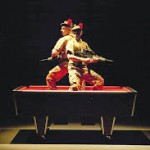
After a visit to the Piedmont Bird Calling Contest on Friday night, as detailed in my last blog post, my weekend took a more serious turn with performances of The National Theatre of Scotland’s Black Watch at the American Conservatory Theater and Beethoven’s Missa Solemnis and an excerpt from Palestrina’s Missa Papae Marcelli at the San Francisco Symphony.
A few words about each:
First, to Davies Symphony Hall. The combined forces of the San Francisco Symphony and Chorus under the baton of Michael Tilson Thomas made a glittering, robust sound and made much of the whopping contrasts between the epic ensemble sections and the sudden quite moments for solo voice and/or violin and quiet accompaniment. Of the soloists, I was  most moved by the performances by mezzo-soprano Sasha Cooke, who’s warm utterance of “et incarnatus est” in the “Credo” movement transported me, and tenor Michael Fabiano. The high-pitched heroic opening to the mass, which sees the tenor “battling the elements” against full orchestra and chorus was chilling. Hearing this tenor made me wish that I could have been at one of his performances of the Beethoven song cycle “An die ferne Geliebte” last week. The performance was preceded by a warm and emotional performance by the a cappella chorus of the “Kyrie,” “Gloria” and “Agnus Dei” movements from Palestrina’s Missa Papae Marcelli. I tend to prefer Palestrina’s works performed on a slightly smaller scale for the sake of intimacy. There were 120 singers on stage for this rendition and under the circumstances, they made a warm, emotional sound and beautifully captured the contours of Palestrina’s writing. The piece made for a somewhat truncated first part to the concert, and yet helped to draw the link between the high Renaissance style and Beethoven’s use of its modes and moods in his great Missa.
Now for some quick thoughts about Black Watch. It’s so often the case that by the time big touring theatre productions make it to San Francisco they are over. By this, I mean that they’ve been seen by audiences everywhere and written about to death. More often than not, the productions feel stale too. Black Watch, a play about a famous Scottish platoon’s rough time backing up the American army during the war in Iraq, dates back to 2006 and has circumnavigated the globe several times since then. Only now is it reaching our quaint little backwater, imported by the American Conservatory Theater. Yet despite the “yesterday’s news” issue, I found myself quite engrossed by the show. Part of its glow stems from the use of the cavernous, military-historied drill hall of the Mission Armory. Beyond that, the whole thing feels more like a surreal ballet than a play. I found this to be refreshing after sitting through countless more character-focused, narrative-based stories about the war in Iraq. It’s harder to tell a story about an entire platoon on stage than it is to draw people in with a compelling tale about a single person or a couple of people. But playwright Gregory Burke and director John Tiffany manage to do so with humor and pathos. The all-male cast dances and sings during the play, giving it a dream-like quality. Â A passage in which one soldier tells a potted history of the famous 42nd Regiment (aka the Black Watch) while being pushed and lifted around by his colleagues as they use him as a model’s dummy upon which to show off how the battalion’s uniform changed over the centuries. It’s a beautiful, lively sequence. Another amazing moment occurs near the start, when the red-topped pool table upon which soldiers have been playing a game in a bar transforms itself into a bloody womb, out of which two newly-minted soldiers rip and tear their way into the narrative. From that moment we realize that this is no easy birth. Only the framework that surrounds the Iraq story, concerning a researcher collecting information from the members of the platoon for a possible movie project, feels superimposed.
